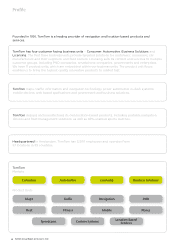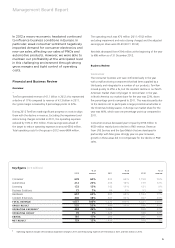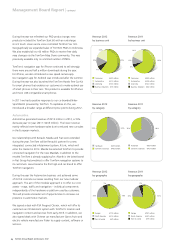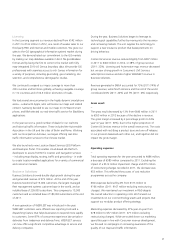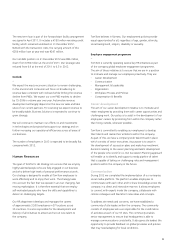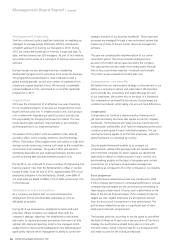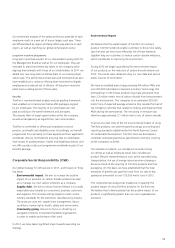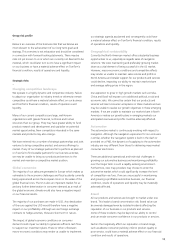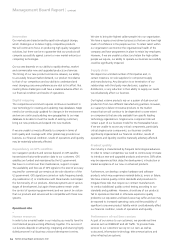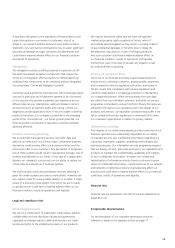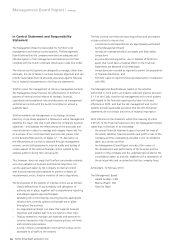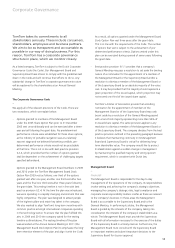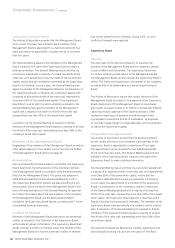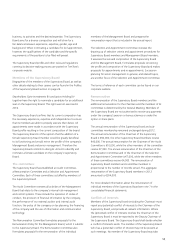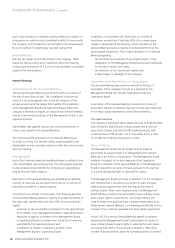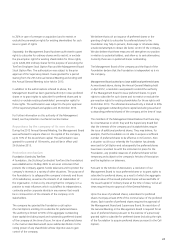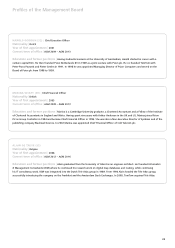TomTom 2012 Annual Report Download - page 15
Download and view the complete annual report
Please find page 15 of the 2012 TomTom annual report below. You can navigate through the pages in the report by either clicking on the pages listed below, or by using the keyword search tool below to find specific information within the annual report.13
Group risk profi le
—
Below is an overview of the business risks that we believe are
most relevant to the achievement of our long-term goals and
strategy. This overview is not exhaustive and should be considered
in connection with forward-looking statements. There may be
risks not yet known to us or which are currently not deemed to be
material, which could later turn out to have a signifi cant impact
on our business or have a material adverse effect on TomTom’s
fi nancial condition, results of operations and liquidity.
Strategic risks
—
Changing competitive landscape
We operate in a highly dynamic and competitive industry. Failure
to adapt our organisation to industry trends or otherwise remain
competitive could have a material adverse effect on our business
and TomTom’s fi nancial condition, results of operations and
liquidity.
Many of our current competitors are large, well-known
organisations with greater fi nancial, technical and human
resources than our group. They may have greater ability to fund
product research and development and capitalise on potential
market opportunities. New competitors interested in the same
markets and products may also emerge.
We have entered into a number of strategic partnerships and joint
ventures to bring competitive product and service offerings to
market. If any of our strategic partners fail to perform as planned
or if we fail to fi nd suitable partners for our business activities,
we may be unable to bring our products and services to the
market and maintain a competitive market position.
Global economics
The majority of our sales are generated in Europe which makes us
vulnerable to the economic challenges and fi scal austerity currently
being experienced across the European Union in the wake of the
global fi nancial crisis. The US is also an important market for us
and any further deterioration in consumer demand as a result of
the global economic climate would also have a negative impact
on our fi nancial results.
The majority of our purchases are made in USD. Any devaluation
of the euro against the USD would therefore have a negative
impact on our profi tability. Although we use foreign exchange
contracts to hedge activities, these are short term in nature.
The impact of global economic conditions on consumer
demand could impair our ability to generate suffi cient cash fl ow
to support our investment plans. These or other unforeseen
macro-economic conditions may render us unable to implement
our strategic agenda as planned and consequently could have
a material adverse effect on TomTom’s fi nancial condition, results
of operations and liquidity.
Geographical sustainability
Currently the North American market offers substantial business
opportunities to us, especially as regards sales of navigation
solutions. We view maintaining and preferably growing market
share as a vital element of being successful in the US market.
However, macro-economic conditions and competitive effects
may render us unable to maintain sales volume and profi ts in
North America and retailer support for our products and services
could decline, impacting our ability to maintain market share
and average selling prices in the region.
Our aspiration to grow in high growth markets such as India,
China and Brazil will expose us to additional political, social and
economic risks. We cannot be certain that our products and
services will meet consumer acceptance in these markets and we
may be unable to realise our growth objectives in these emerging
markets. If we are unable to maintain our market share in North
America or realise our growth plans in emerging markets our
anticipated revenues and profi ts could be adversely affected.
Automotive
The automotive market is continuously evolving with respect to
navigation. Although the navigation experience for our end-users
is similar, whether the navigation system is built in the dash or
provided on a PND, the dynamics of supplying to the automotive
industry are very different from those for delivering mass-market
consumer electronics.
There are additional operational and technical challenges in
growing our automotive business and maintaining profi tability
over the longer term in such a rapidly evolving environment.
Furthermore, new map providers may choose to enter the
automotive market which could signifi cantly increase the level
of competition we face. If we are unsuccessful in maintaining
and growing a profi table automotive business, our fi nancial
condition, results of operations and liquidity may be materially
adversely affected.
Brand
All our products and services are brought to market under one
brand. This leads to brand concentration risk. Brand value can
be severely damaged even by isolated incidents affecting the
reputation of our business or our products and services.
Some of these incidents may be beyond our ability to control
and can erode consumer confi dence in our products or services.
Factors that negatively affect our reputation or brand image,
such as adverse consumer publicity, inferior product quality or
poor service, could have a material adverse effect on our fi nancial
condition and results of operations.



